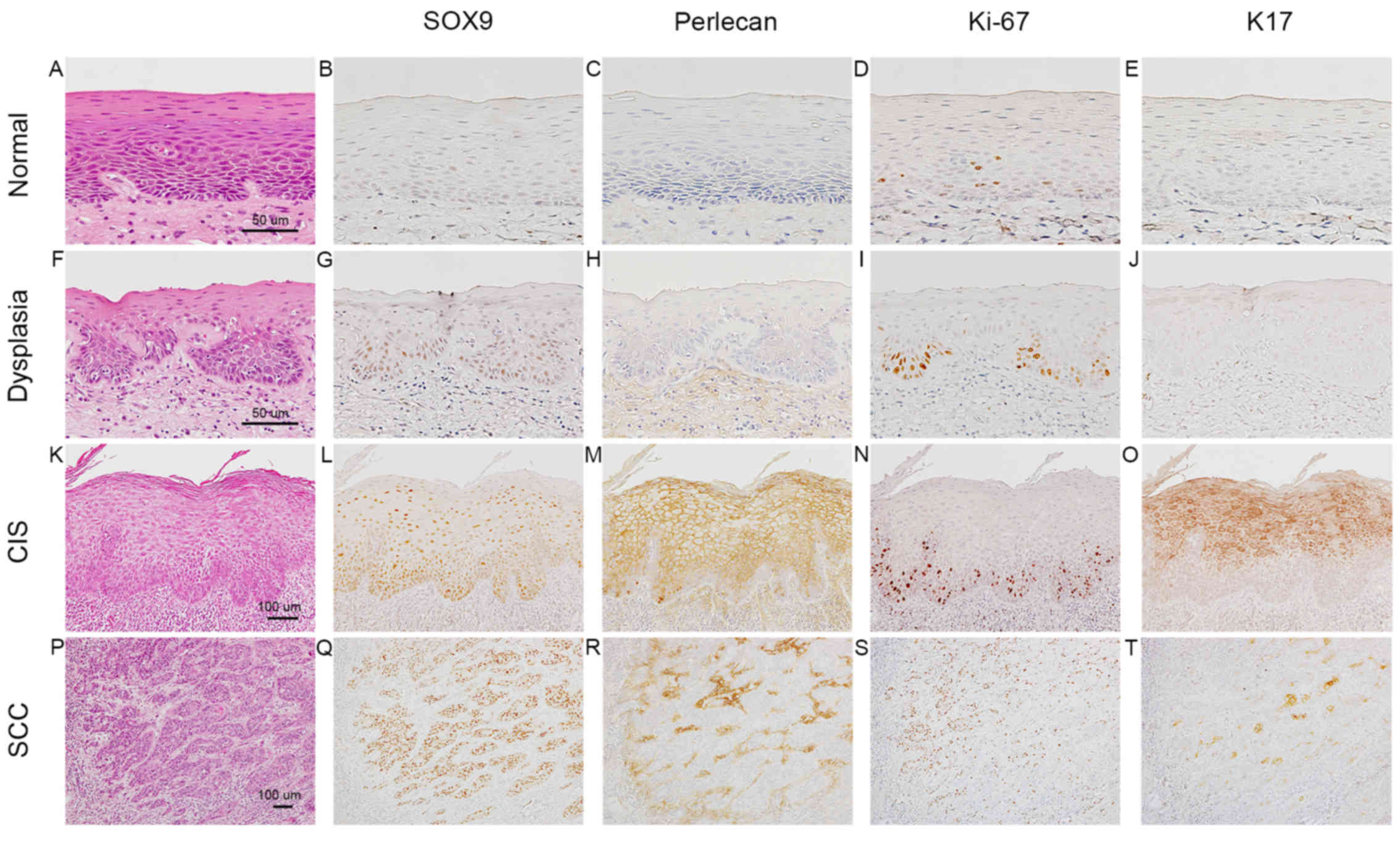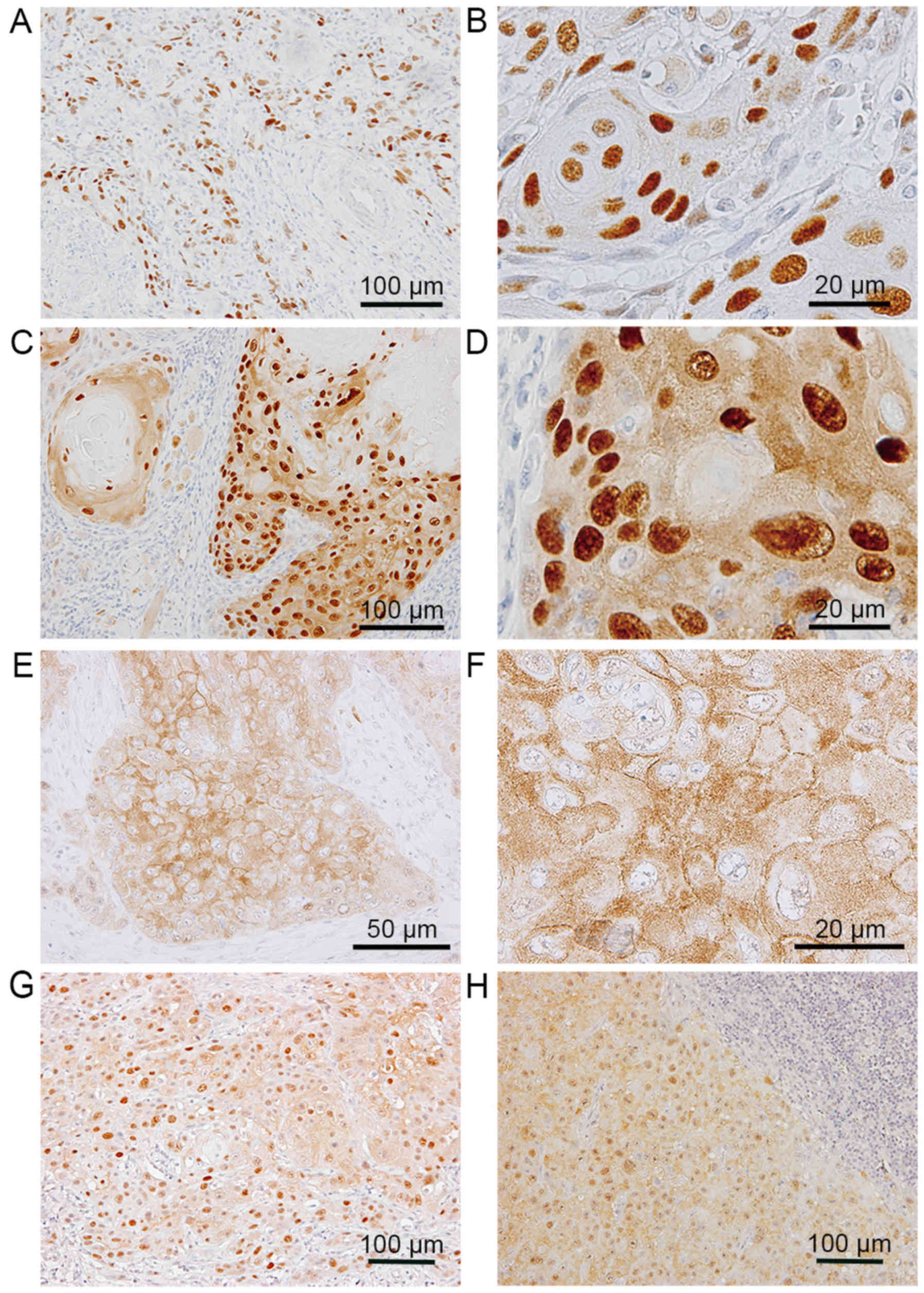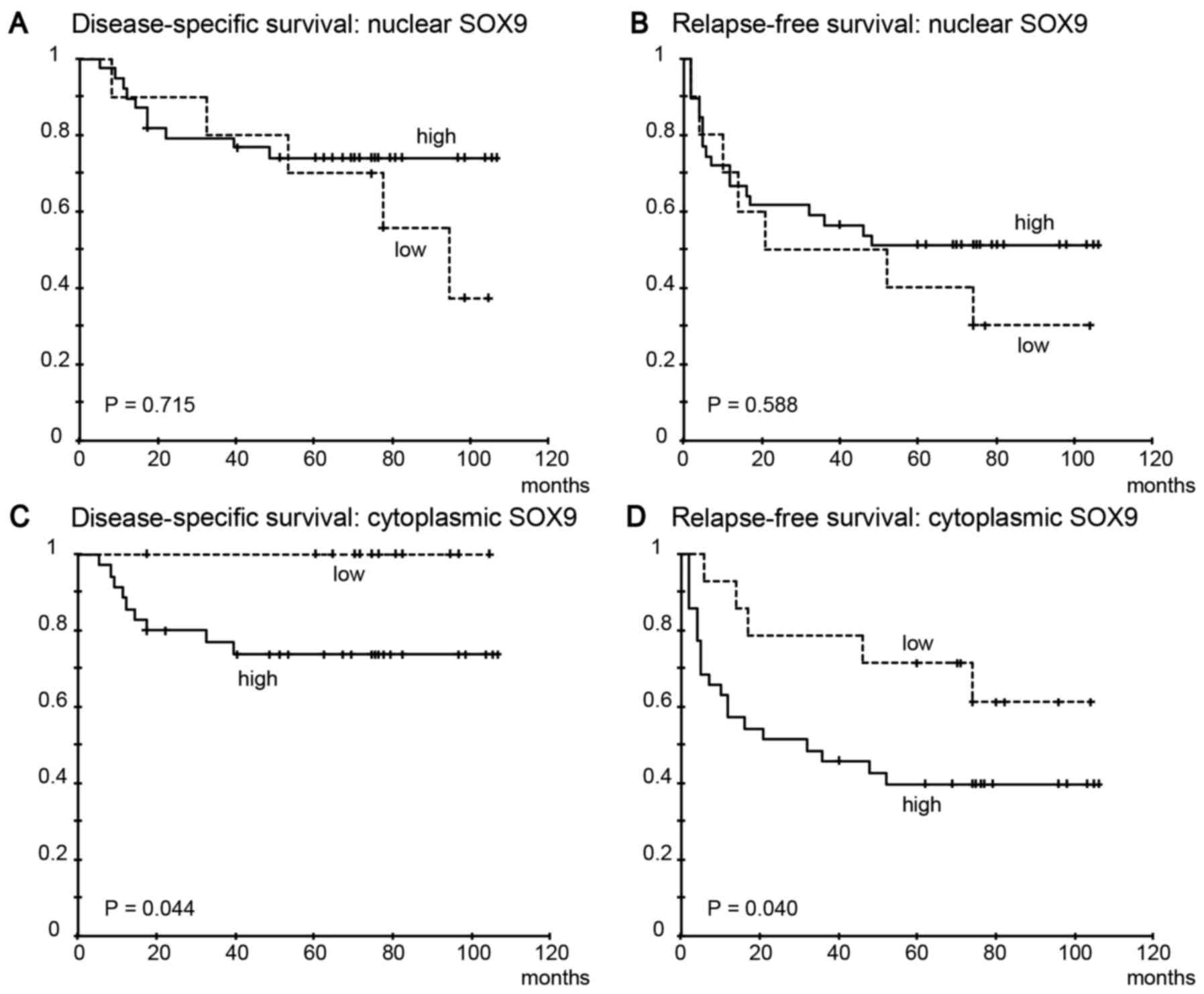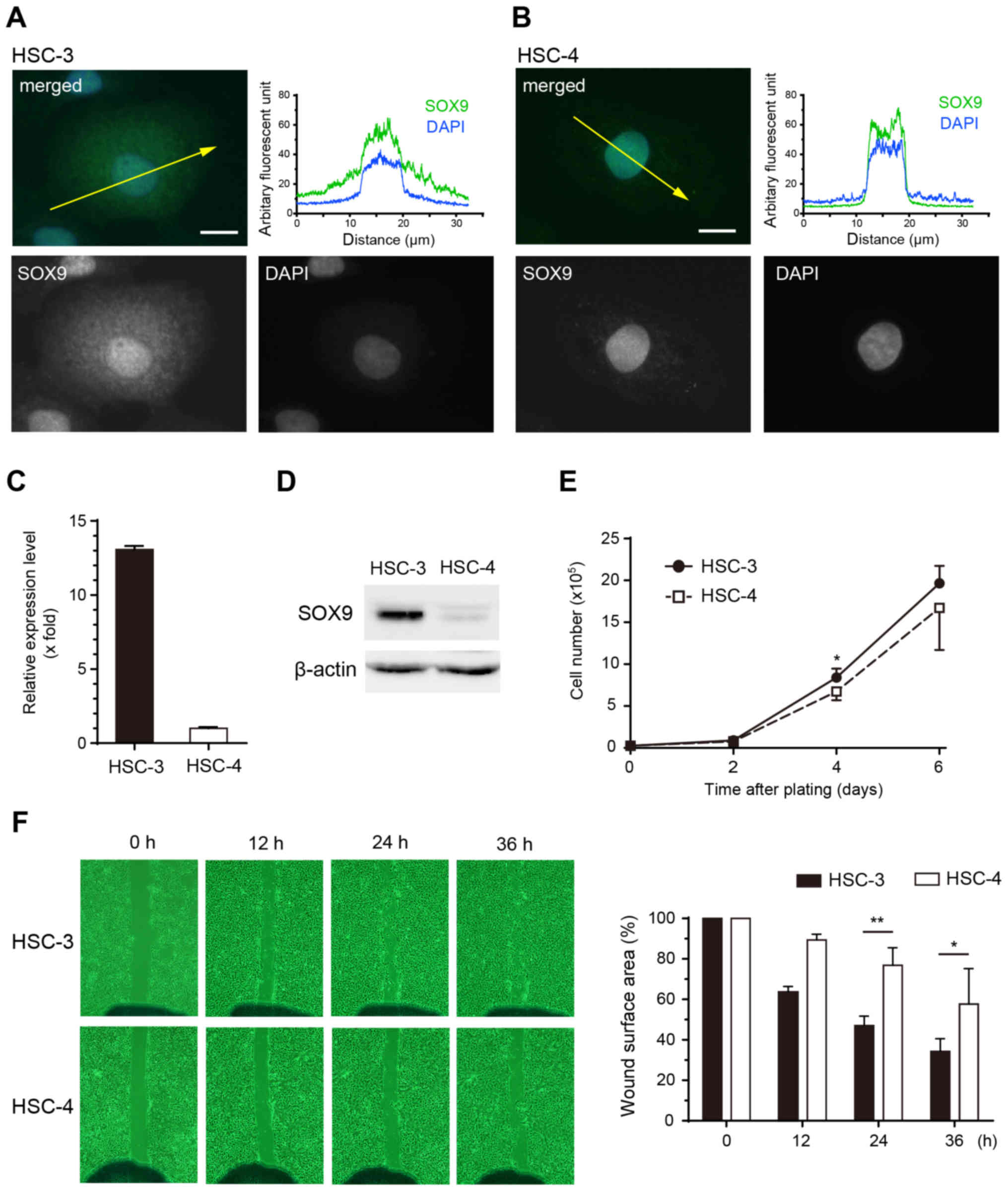|
1
|
Jo A, Denduluri S, Zhang B, Wang Z, Yin L,
Yan Z, Kang R, Shi LL, Mok J, Lee MJ and Haydon RC: The versatile
functions of Sox9 in development, stem cells, and human diseases.
Genes Dis. 1:149–161. 2014. View Article : Google Scholar : PubMed/NCBI
|
|
2
|
Pritchett J, Athwal V, Roberts N, Hanley
NA and Hanley KP: Understanding the role of SOX9 in acquired
diseases: Lessons from development. Trends Mol Med. 17:166–174.
2011. View Article : Google Scholar : PubMed/NCBI
|
|
3
|
Harley VR, Clarkson MJ and Argentaro A:
The molecular action and regulation of the testis-determining
factors, SRY (sex-determining region on the Y chromosome) and SOX9
[SRY-related high-mobility group (HMG) box 9]. Endocr Rev.
24:466–487. 2003. View Article : Google Scholar : PubMed/NCBI
|
|
4
|
Akiyama H: Control of chondrogenesis by
the transcription factor Sox9. Mod Rheumatol. 18:213–219. 2008.
View Article : Google Scholar : PubMed/NCBI
|
|
5
|
Vidal VP, Chaboissier MC, Lutzkendorf S,
Cotsarelis G, Mill P, Hui CC, Ortonne N, Ortonne JP and Schedl A:
Sox9 is essential for outer root sheath differentiation and the
formation of the hair stem cell compartment. Curr Biol.
15:1340–1351. 2005. View Article : Google Scholar : PubMed/NCBI
|
|
6
|
Shi G, Sohn KC, Li Z, Choi DK, Park YM,
Kim JH, Fan YM, Nam YH, Kim S, Im M, et al: Expression and
functional role of Sox9 in human epidermal keratinocytes. PLoS One.
8:e543552013. View Article : Google Scholar : PubMed/NCBI
|
|
7
|
Wang H, McKnight NC, Zhang T, Lu ML, Balk
SP and Yuan X: SOX9 is expressed in normal prostate basal cells and
regulates androgen receptor expression in prostate cancer cells.
Cancer Res. 67:528–536. 2007. View Article : Google Scholar : PubMed/NCBI
|
|
8
|
Chakravarty G, Moroz K, Makridakis NM,
Lloyd SA, Galvez SE, Canavello PR, Lacey MR, Agrawal K and Mondal
D: Prognostic significance of cytoplasmic SOX9 in invasive ductal
carcinoma and metastatic breast cancer. Exp Biol Med. 236:145–155.
2011. View Article : Google Scholar
|
|
9
|
Lü B, Fang Y, Xu J, Wang L, Xu F, Xu E,
Huang Q and Lai M: Analysis of SOX9 expression in colorectal
cancer. Am J Clin Pathol. 130:897–904. 2008. View Article : Google Scholar : PubMed/NCBI
|
|
10
|
Vidal VP, Ortonne N and Schedl A: SOX9
expression is a general marker of basal cell carcinoma and
adnexal-related neoplasms. J Cutan Pathol. 35:373–379. 2008.
View Article : Google Scholar : PubMed/NCBI
|
|
11
|
Hong Y, Chen W, Du X, Ning H, Chen H, Shi
R, Lin S, Xu R, Zhu J, Wu S, et al: Upregulation of sex-determining
region Y-box 9 (SOX9) promotes cell proliferation and
tumorigenicity in esophageal squamous cell carcinoma. Oncotarget.
6:31241–31254. 2015. View Article : Google Scholar : PubMed/NCBI
|
|
12
|
Ikarashi T, Ida-Yonemochi H, Ohshiro K,
Cheng J and Saku T: Intraepithelial expression of perlecan, a
basement membrane-type heparan sulfate proteoglycan reflects
dysplastic changes of the oral mucosal epithelium. J Oral Pathol
Med. 33:87–95. 2004. View Article : Google Scholar : PubMed/NCBI
|
|
13
|
Maruyama S, Shimazu Y, Kudo T, Sato K,
Yamazaki M, Abé T, Babkair H, Cheng J, Aoba T and Saku T:
Three-dimensional visualization of perlecan-rich neoplastic stroma
induced concurrently with the invasion of oral squamous cell
carcinoma. J Oral Pathol Med. 43:627–636. 2014. View Article : Google Scholar : PubMed/NCBI
|
|
14
|
Maruyama S, Cheng J, Yamazaki M, Liu A and
Saku T: Keratinocyte growth factor colocalized with perlecan at the
site of capsular invasion and vascular involvement in salivary
pleomorphic adenomas. J Oral Pathol Med. 38:377–385. 2009.
View Article : Google Scholar : PubMed/NCBI
|
|
15
|
Toyoshima K, Kimura S, Cheng J, Oda Y,
Mori KJ and Saku T: High-molecular-weight fibronectin synthesized
by adenoid cystic carcinoma cells of salivary gland origin. Jpn J
Cancer Res. 90:308–319. 1999. View Article : Google Scholar : PubMed/NCBI
|
|
16
|
Hasegawa M, Cheng J, Maruyama S, Yamazaki
M, Abé T, Babkair H, Saito C and Saku T: Differential
immunohistochemical expression profiles of perlecan-binding growth
factors in epithelial dysplasia, carcinoma in situ, and squamous
cell carcinoma of the oral mucosa. Pathol Res Pract. 212:426–436.
2016. View Article : Google Scholar : PubMed/NCBI
|
|
17
|
Warren CR, Grindel BJ, Francis L, Carson
DD and Farach-Carson MC: Transcriptional activation by NFkappaB
increases perlecan/HSPG2 expression in the desmoplastic prostate
tumor microenvironment. J Cell Biochem. 115:1322–1333. 2014.
View Article : Google Scholar : PubMed/NCBI
|
|
18
|
Larsimont JC, Youssef KK, Sánchez-Danés A,
Sukumaran V, Defrance M, Delatte B, Liagre M, Baatsen P, Marine JC,
Lippens S, et al: Sox9 controls self-renewal of oncogene targeted
cells and links tumor initiation and invasion. Cell Stem Cell.
17:60–73. 2015. View Article : Google Scholar : PubMed/NCBI
|
|
19
|
UICC International Union Against Cancer:
TNM Classification of Malignant Tumours. Sobin LH, Gospodarowicz MK
and Wittekind C: 7th edition. Wiley-Blackwell; Hoboken, NJ: pp.
25–28. 2009
|
|
20
|
Saku T and Furthmayr H: Characterization
of the major heparan sulfate proteoglycan secreted by bovine aortic
endothelial cells in culture. Homology to the large molecular
weight molecule of basement membranes. J Biol Chem. 264:3514–3523.
1989.PubMed/NCBI
|
|
21
|
Momose F, Araida T, Negishi A, Ichijo H,
Shioda S and Sasaki S: Variant sublines with different metastatic
potentials selected in nude mice from human oral squamous cell
carcinomas. J Oral Pathol Med. 18:391–395. 1989. View Article : Google Scholar : PubMed/NCBI
|
|
22
|
Livak KJ and Schmittgen TD: Analysis of
relative gene expression data using real-time quantitative PCR and
the 2−ΔΔCT method. Methods. 25:402–408. 2001.
View Article : Google Scholar : PubMed/NCBI
|
|
23
|
Yamazaki M, Maruyama S, Abé T, Essa A,
Babkair H, Cheng J and Saku T: MFG-E8 expression for progression of
oral squamous cell carcinoma and for self-clearance of apoptotic
cells. Lab Invest. 94:1260–1272. 2014. View Article : Google Scholar : PubMed/NCBI
|
|
24
|
Ahsan MS, Yamazaki M, Maruyama S,
Kobayashi T, Ida-Yonemochi H, Hasegawa M, Ademola Henry A, Cheng J
and Saku T: Differential expression of perlecan receptors,
α-dystroglycan and integrin β1, before and after invasion of oral
squamous cell carcinoma. J Oral Pathol Med. 40:552–559. 2011.
View Article : Google Scholar : PubMed/NCBI
|
|
25
|
Kobayashi T, Maruyama S, Cheng J,
Ida-Yonemochi H, Yagi M, Takagi R and Saku T: Histopathological
varieties of oral carcinoma in situ: Diagnosis aided by
immunohistochemistry dealing with the second basal cell layer as
the proliferating center of oral mucosal epithelia. Pathol Int.
60:156–166. 2010. View Article : Google Scholar : PubMed/NCBI
|
|
26
|
Mikami T, Cheng J, Maruyama S, Kobayashi
T, Funayama A, Yamazaki M, Adeola HA, Wu L, Shingaki S, Saito C and
Saku T: Emergence of keratin 17 vs. loss of keratin 13: Their
reciprocal immunohistochemical profiles in oral carcinoma in situ.
Oral Oncol. 47:497–503. 2011. View Article : Google Scholar : PubMed/NCBI
|
|
27
|
Jiang SS, Fang WT, Hou YH, Huang SF, Yen
BL, Chang JL, Li SM, Liu HP, Liu YL, Huang CT, et al: Upregulation
of SOX9 in lung adenocarcinoma and its involvement in the
regulation of cell growth and tumorigenicity. Clin Cancer Res.
16:4363–4373. 2010. View Article : Google Scholar : PubMed/NCBI
|
|
28
|
Alvarado CG, Maruyama S, Cheng J,
Ida-Yonemochi H, Kobayashi T, Yamazaki M, Takagi R and Saku T:
Nuclear translocation of β-catenin synchronized with loss of
E-cadherin in oral epithelial dysplasia with a characteristic
two-phase appearance. Histopathology. 59:283–291. 2011. View Article : Google Scholar : PubMed/NCBI
|
|
29
|
Malki S, Berta P, Poulat F and
Boizet-Bonhoure B: Cytoplasmic retention of the sex-determining
factor SOX9 via the microtubule network. Exp Cell Res. 309:468–475.
2005. View Article : Google Scholar : PubMed/NCBI
|
|
30
|
Oz Bar M, Kumar A, Elayyan J, Reich E,
Binyamin M, Kandel L, Liebergall M, Steinmeyer J, Lefebvre V and
Dvir-Ginzberg M: Acetylation reduces SOX9 nuclear entry and
ACAN gene transactivation in human chondrocytes. Aging Cell.
15:499–508. 2016. View Article : Google Scholar : PubMed/NCBI
|
|
31
|
Sim H, Argentaro A and Harley VR: Boys,
girls and shuttling of SRY and SOX9. Trends Endocrinol Metab.
19:213–222. 2008. View Article : Google Scholar : PubMed/NCBI
|
|
32
|
Guo W, Keckesova Z, Donaher JL, Shibue T,
Tischler V, Reinhardt F, Itzkovitz S, Noske A, Zürrer-Härdi U, Bell
G, et al: Slug and Sox9 cooperatively determine the mammary stem
cell state. Cell. 148:1015–1028. 2012. View Article : Google Scholar : PubMed/NCBI
|
|
33
|
Fazilaty H, Gardaneh M, Akbari P, Zekri A
and Behnam B: SLUG and SOX9 cooperatively regulate tumor initiating
niche factors in breast cancer. Cancer Microenviron. 9:71–74. 2016.
View Article : Google Scholar : PubMed/NCBI
|
|
34
|
Savagner P, Yamada KM and Thiery JP: The
zinc-finger protein slug causes desmosome dissociation, an initial
and necessary step for growth factor-induced epithelial-mesenchymal
transition. J Cell Biol. 137:1403–1419. 1997. View Article : Google Scholar : PubMed/NCBI
|
|
35
|
Sadatsuki R, Kaneko H, Kinoshita M, Futami
I, Nonaka R, Culley KL, Otero M, Hada S, Goldring MB, Yamada Y, et
al: Perlecan is required for the chondrogenic differentiation of
synovial mesenchymal cells through regulation of Sox9 gene
expression. J Orthop Res. 35:837–846. 2017. View Article : Google Scholar : PubMed/NCBI
|
|
36
|
Khanom R, Nguyen CT, Kayamori K, Zhao X,
Morita K, Miki Y, Katsube K, Yamaguchi A and Sakamoto K: Keratin 17
is induced in oral cancer and facilitates tumor growth. PLoS One.
11:e01611632016. View Article : Google Scholar : PubMed/NCBI
|


















